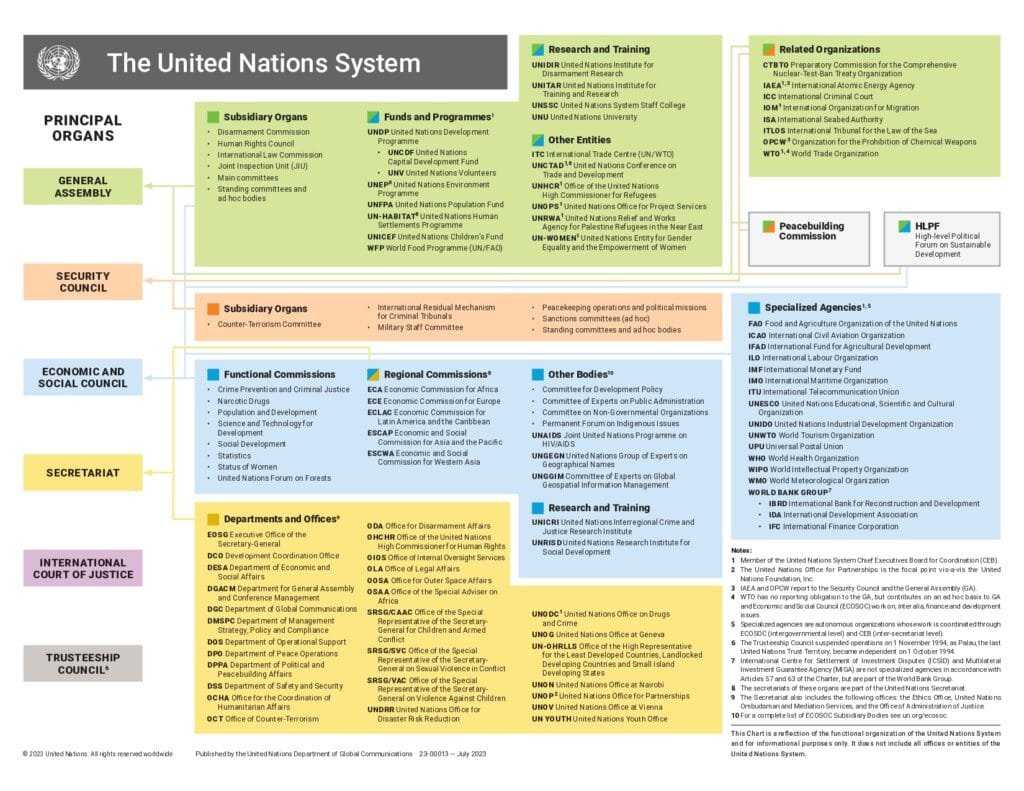
The Organizational Structure of the United Nations
The United Nations (UN) is an international organization founded after second world war in 1945 by 51 countries committed to maintaining international peace and security, developing friendly relations among nations, achieving international cooperation in international problems, promoting fundamental freedoms and human rights. The United Nations is established and governed by the “United Nations Charter” and this document defines the organizational structure of the United Nations. There are six major parts of the United Nations Organization also known as the principal organs of the United Nations, each having its specific role and structure in the United Nations Organization.
Principal Organs of the United Nations
The organizational structure of the United Nations consists of six principal organs, each with distinct functions and responsibilities:
1. The General Assembly (GA)
The General Assembly is the main deliberative body of the UN, where all 193 member states have equal representation. It discusses and makes decisions on a range of international issues covered by the Charter of the United Nations, including development, peace and security, international law, and human rights. The decisions of the General Assembly on important questions mentioned in Article 18(2) are made by a two-thirds majority of members present and voting and on other issues the decision thereof is made by a simple majority of present members. The GA has six subsidiary organs: Disarmament Commission, Human Rights Council, International Law Commission, Joint Inspection Unit, Main Committees and Standing Committees.
2. The Security Council (SC)
The Security Council is the most powerful political part in the organizational structure of the United Nations. It is responsible for maintaining international peace and security. Security Council consists of 15 members, including five permanent members with veto power (China, France, Russia, the United Kingdom, and the United States) and ten non-permanent members elected for two-year terms. It can impose sanctions, authorize the use of force to maintain or restore international peace and security, and establish peacekeeping operations. The decisions of the Security Council for the maintenance of international peace and security are binding on all the members of the United Nations.
3. The International Court of Justice (ICJ)
The ICJ is the principal judicial organ of the United Nations. It is located in The Hague, Netherlands. The International Court of Justice settles legal disputes between states according to international law and gives advisory opinions on legal questions referred to it by the General Assembly or the Security Council.
4. The Secretariat
The Secretariat carries out the day-to-day work of the UN as mandated by the General Assembly, the Security Council, and other organs. It is headed by the Secretary-General, who is appointed by the General Assembly on the recommendation of the Security Council for a five-year renewable term. It administers peacekeeping operations, mediates international disputes, surveys economic and social trends, and organizes international conferences.
5. The Economic and Social Council (ECOSOC)
ECOSOC coordinates the economic, social, and related work of 15 UN specialized agencies, their functional commissions, and five regional commissions. It has 54 members, elected by the General Assembly for overlapping three-year terms. It promotes international economic and social cooperation and development, oversees specialized agencies, and ensures policy coherence.
6. The Trusteeship Council
Established to oversee the administration of trust territories as they transitioned to self-government or independence. Its work has been suspended since the last trust territory, Palau, became independent in 1994.
Conclusion
The organizational structure of the United Nations is a complex and multifaceted system designed to address a wide array of global issues. Its principal organs and specialized agencies work collaboratively to promote peace, security, development, human rights, and international cooperation. Through its comprehensive framework, the UN strives to build a better world by addressing the challenges faced by humanity in the 21st century.
